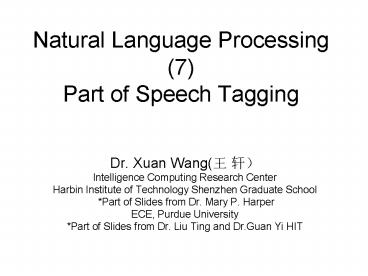Natural Language Processing 7 Part of Speech Tagging - PowerPoint PPT Presentation
1 / 68
Title:
Natural Language Processing 7 Part of Speech Tagging
Description:
Intelligence Computing Research Center. Harbin Institute of Technology ... (Computer Science), 1955 A.B. summa cum laude, Duke University, Physics, 1953. ... – PowerPoint PPT presentation
Number of Views:56
Avg rating:3.0/5.0
Title: Natural Language Processing 7 Part of Speech Tagging
1
Natural Language Processing(7)Part of Speech
Tagging
- Dr. Xuan Wang(? ?)
- Intelligence Computing Research Center
- Harbin Institute of Technology Shenzhen Graduate
School - Part of Slides from Dr. Mary P. Harper
- ECE, Purdue University
- Part of Slides from Dr. Liu Ting and Dr.Guan Yi
HIT
2
Part of Speech Tagging
3
Penn Treebank Tag Set
4
Tagging Example
5
Baseline Tagging Accuracy
- In general, if you always select the most likely
part of speech for a word in the training data,
it is easy to obtain a 90 success rate largely
because approximately 50 of the words in a
typical corpus are not ambiguous. Hence, this is
a baseline against which a good model must
measure itself. - It is possible to do better than 90 accuracy by
using more information from the sentence a word
appears in. For example, if a word follows a
determiner, it is not likely that it is a verb.
6
Information Sources
7
Early Approaches
8
Statistical Approaches (Overview)
9
Tagging and The Noisy Channel
10
Notation
11
A Tagging HMM Model
12
The Equations
13
The Equations
14
The Equations
15
The Equations
16
Estimating Probabilities
17
Estimating Probabilities
18
Obtaining Probabilities
19
Estimation of SyntagmaticProbabilities
20
Estimation of Lexical Probabilities
21
Word/Tag Counts
22
Lexical Probability Estimates
23
The HMM Tagger
24
The Probability of a State Sequence for a Sentence
25
Efficient Tagging
26
(No Transcript)
27
Viterbi Algorithm
28
Viterbi Algorithm
29
(No Transcript)
30
(No Transcript)
31
(No Transcript)
32
(No Transcript)
33
(No Transcript)
34
(No Transcript)
35
(No Transcript)
36
(No Transcript)
37
(No Transcript)
38
(No Transcript)
39
(No Transcript)
40
(No Transcript)
41
(No Transcript)
42
(No Transcript)
43
(No Transcript)
44
(No Transcript)
45
(No Transcript)
46
(No Transcript)
47
(No Transcript)
48
(No Transcript)
49
(No Transcript)
50
(No Transcript)
51
(No Transcript)
52
(No Transcript)
53
(No Transcript)
54
(No Transcript)
55
(No Transcript)
56
(No Transcript)
57
(No Transcript)
58
(No Transcript)
59
(No Transcript)
60
(No Transcript)
61
(No Transcript)
62
(No Transcript)
63
(No Transcript)
64
Worlds Superstar1999 Turing Award Winners
- Frederick P. Brooks, Jr.
- For landmark contributions to computer
architecture, operating systems, and software
engineering.
65
Frederick P. Brooks, Jr.
- EDUCATION Ph.D., Harvard University, Applied
Mathematics (Computer Science), 1956 Howard H.
Aiken, advisor dissertation The Analytic Design
of Automatic Data Processing Systems S.M.,
Harvard University, Applied Mathematics (Computer
Science), 1955 A.B. summa cum laude, Duke
University, Physics, 1953. First in class of
1953. - TEACHING EXPERIENCE University of North Carolina
at Chapel Hill, Department of Computer Science
Kenan Professor of Computer Science, 1975-
Professor of Computer Science, 1964-75 Chairman,
1964-1984 founder Twente Technical University,
Enschede, The Netherlands Visiting Professor,
1970 Columbia University Adjunct Assistant
Professor, 1960-61 Vassar College Visiting
Instructor, 1958 IBM Systems Research Institute,
Voluntary Education Program, and Summer Student
Program Teacher, 1957-59
66
- DEVELOPMENT EXPERIENCE IBM Corporation
Poughkeepsie, New York Corporate Processor
Manager for Development of System/360 Computer
Systems, 1961-1965 Manager of Operating
System/360, 1964-65 Manager, System/360 Hardware
Development, Data Systems Division, 1961-64
Systems Planning Manager, Data Systems Division
(8000 series et al.), 1960-61 Yorktown Heights,
New York Advisory Engineer, Thomas J. Watson
Research Center, 1959-60 Poughkeepsie, New York
Project STRETCH Advisory Engineer, 1958-59
Staff Engineer, 1956-58 Associate Engineer, 1956
Professional summer jobs at IBM Endicott, Bell
Labs, North American Aviation, Marathon Oil Co.,
1952-56 - COMPUTER DESIGNS IBM System/360 Manager of whole
project, 1961-64 IBM 8000 Series (never
produced) Manager of Architecture, 1960-61 IBM
7950 (Harvest) Instruction set-up, adjustments,
1957-58 IBM 7030 (Stretch) Instruction
sequencing, interruption, variable-field-length
arithmetic, editing, programmable console,
1956-59 A specialized computer for payroll, Ph.D.
Dissertation, 1955-56
67
Project Walkthrough
68
- Thanks!










![An Italian-English dependency parser and its [possible] application to Hindi Leonardo Lesmo (lesmo@di.unito.it) Natural Language Processing Group (Dip. Informatica PowerPoint PPT Presentation](https://s3.amazonaws.com/images.powershow.com/7541733.th0.jpg?_=20160116129)




















